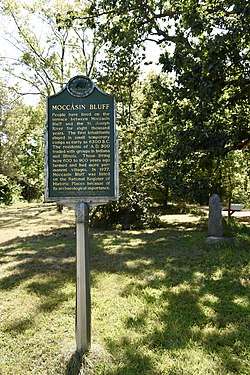Moccasin Bluff Site
|
Moccasin Bluff Site | |
 | |
  | |
| Location | Red Bud Trail near Buchanan, Michigan[1] |
|---|---|
| Coordinates | 41°51′20″N 86°22′0″W / 41.85556°N 86.36667°WCoordinates: 41°51′20″N 86°22′0″W / 41.85556°N 86.36667°W |
| Area | 5 acres (2.0 ha) |
| NRHP reference # | 77000710[2] |
| Added to NRHP | April 13, 1977 |
The Moccasin Bluff Site (also designated 20BE8) is an archaeological site located along Red Bud Trail and the St. Joseph River north of Buchanan, Michigan. It was listed on the National Register of Historic Places in 1977.[2]
History
The terrace between Moccasin Bluff and the St. Joseph River was home to temporary camps as early as 6300 B.C. Around A.D 500, inhabitants here traded with other groups of Native Americans from Illinois and Indiana. By A.D. 1100-1400, more permanent villages were established here, and the residents farmed the local lands.[3]
By the late 1820s, European settlers moved into the area to log and farm the land. The US government then adopted a policy of moving the local Potawatomi out of the area and further west. This bluff is said to be named for Cogomoccasin, leader of one of the nearby displaced Potawatomi villages. [3]
In 1948, the site was excavated by a University of Michigan team, which found pottery, skeletal remains and remnants of corn and storage pits. In 2002, Michigan State University excavated a wetland area at a lower elevation that had not been previously examined.[4]
Description
The Moccasin Bluff Site is located on a terrace along Red Bud Trail. The terrace overlooks a wide bend in the St. Joseph River containing a pair of islands. The site is protected by a half-circle of hills to the north, west and south.[4]
The site contained large numbers of pits of four different types: storage pits, fire pits (possibly used for baking), hearths, and smudge pits (found to contain Eastern complex corn).[5]
References
- ↑ The NRIS lists the Moccasin Bluff Site as "Address Restricted." However, the State of Michigan has erected a historical marker at the site (Moccasin Bluff from MichMarkers.org).
- 1 2 National Park Service (2010-07-09). "National Register Information System". National Register of Historic Places. National Park Service.
- 1 2 Laura R. Ashlee, ed. (2005), Traveling Through Time: A Guide to Michigan's Historical Markers, University of Michigan Press, p. 42, ISBN 9780472030668
- 1 2 Andy Hamilton (February 23, 2007), "Moccasin Bluff a look back at local prehistory", Niles Daily Star
- ↑ William A. Lovis (1974), "Review: The Moccasin Bluff Site and the Woodland Cultures of Southwestern Michigan", American Anthropologist, 76 (2)
Further reading
- Robert Louis Bettarel; Hale Gilliam Smith (1973), The Moccasin Bluff site and the Woodland cultures of southwestern Michigan
- Jodie A. O'Gorman (2007), "The myth of Moccasin Bluff: rethinking the Potawatomi pattern", Ethnohistory, 54 (3): 373–406